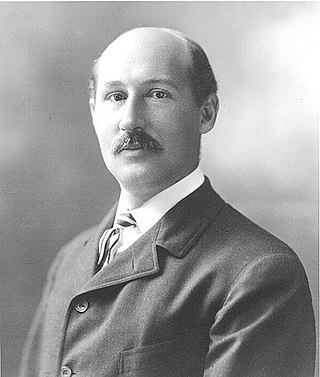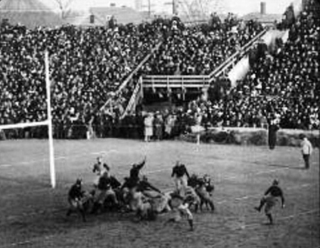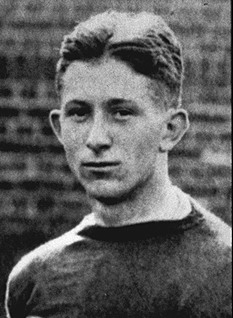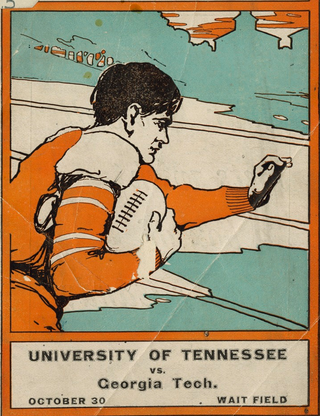Related Research Articles

The 1910 College Football All-America team is composed of college football players who were selected as All-Americans for the 1910 college football season. The only selector for the 1910 season who has been recognized as "official" by the National Collegiate Athletic Association (NCAA) is Walter Camp. Many other sports writers, newspapers, coaches and others also selected All-America teams in 1910. The magazine Leslie's Weekly attempted to develop a consensus All-American by polling 16 football experts and aggregating their votes. Others who selected All-Americans in 1911 include The New York Times, The New York Sun, and sports writer Wilton S. Farnsworth of the New York Evening Journal.

The 1906 college football season was the first in which the forward pass was permitted. Although there was no clear cut national championship, there were two teams that had won all nine of their games as the 1906 season drew to a close, the Princeton Tigers and the Yale Bulldogs, and on November 17, 1906, they played to a 0–0 tie. St. Louis University finished at 11–0–0. The Helms Athletic Foundation, founded in 1936, declared retroactively that Princeton had been the best college football team of 1906. Other selectors recognized Yale as the national champions for 1906.

The 1911 college football season was the last one before major reforms were made to the American game in 1912. In 1911, touchdowns were worth five points, the field was 110 yards in length, and a team had three downs within which to advance the ball ten yards. The United States Naval Academy (Navy) finished with a record of 6 wins and 3 ties (6–0–3). Two of the ties were 0–0 games with the other major unbeaten teams, Penn State (8–0–1) and Princeton (8–0–2). Other teams that finished the season unbeaten were Minnesota (6–0–1) and Florida (5–0–1). The Helms Athletic Foundation, founded in 1936, declared retroactively that Princeton had been the best team of 1911

The 1912 college football season was the first season of the modern era of college football, as the NCAA implemented changes to increase scoring:

The 1908 college football season ran from Saturday, September 19, to November 28. The Penn Quakers and the Harvard Crimson each finished the season unbeaten but with one tied. The LSU Tigers went unbeaten and untied against a weaker opposition. All three teams were named national champions retroactively by various organizations. Only Pennsylvania officially claims a national championship for the 1908 season.

The 1912 College Football All-America team is composed of college football players who were selected as All-Americans for the 1912 college football season. The only selector for the 1912 season who has been recognized as "official" by the National Collegiate Athletic Association (NCAA) is Walter Camp. Many other sports writers, newspapers, coaches and others also selected All-America teams in 1912. One writer, Louis A. Dougher, published a "Composite Eleven" in the Washington Times which consisted of his aggregating the first-team picks of 23 selectors.
The 1921 College Football All-America team is composed of college football players who were selected as All-Americans by various organizations and writers that chose College Football All-America Teams in 1921. The only selector recognized by the NCAA as "official" for the 1921 season is Walter Camp, whose selections were published in Collier's Weekly. Additional selectors who chose All-American teams in 1921 included: Football World magazine, based on collected opinions of 267 coaches; Walter Eckersall of the Chicago Tribune; Jack Veiock, sports editor of the International News Service; and Norman E. Brown of the Central Press Association.
The 1920 College Football All-America team is composed of college football players who were selected as All-Americans by various organizations and writers that chose College Football All-America Teams in 1920. The four selectors recognized by the NCAA as "official" for the 1920 season are (1) Walter Camp (WC), whose selections were published in Collier's Weekly; (2) Football World magazine; (4) the International News Service, a news service operated by the Hearst newspapers; and (3) the Frank Menke syndicate (FM). Additional notable selectors who chose All-American teams in 1920 included Walter Eckersall (WE) of the Chicago Tribune, the United Press (UP), and The New York Times (NYT).
The 1907 College Football All-America team is composed of various organizations that chose basketball teams that season. The organizations that chose the teams included Collier's Weekly selected by Walter Camp.

Donold B. Lourie was an American businessman, government official, and college football player. He served for many years as the president of the Quaker Oats Company, and held various other executive positions there and for several other businesses. President Dwight D. Eisenhower appointed Lourie to a position in the State Department, and he served in that capacity for one year. Lourie attended Princeton University, where he was a star quarterback, and he was named a consensus All-American as a junior. Lourie was inducted into the College Football Hall of Fame in 1974.

The 1909 college football season was the first for the 3-point field goal, which had previously been worth 4 points. The season ran from Saturday, September 25, until Thanksgiving Day, November 25, although a few games were played on the week before.
The 1925 All-Eastern football team consists of American football players chosen by various selectors as the best players at each position among the Eastern colleges and universities during the 1925 college football season.
The 1940 All-Eastern football team consists of American football players chosen by various selectors as the best players at each position among the Eastern colleges and universities during the 1940 college football season.
The 1937 All-Eastern football team consists of American football players chosen by various selectors as the best players at each position among the Eastern colleges and universities during the 1937 college football season.
The 1929 All-Eastern football team consists of American football players chosen by various selectors as the best players at each position among the Eastern colleges and universities during the 1929 college football season.
The 1955 All-Eastern football team consists of American football players chosen by various selectors as the best players at each position among the Eastern colleges and universities during the 1955 college football season.
The 1924 All-Eastern football team consists of American football players chosen by various selectors as the best players at each position among the Eastern colleges and universities during the 1924 college football season.
The 1920 All-Eastern football team consists of American football players chosen by various selectors as the best players at each position among the Eastern colleges and universities during the 1920 college football season.
The 1913 All-Eastern football team consists of American football players chosen by various selectors as the best players at each position among the Eastern colleges and universities during the 1913 college football season.
The 1907 All-Eastern football team consists of American football players chosen by various selectors as the best players at each position among the Eastern colleges and universities during the 1907 college football season.
References
- ↑ "Farrell Picks His All-Eastern Football Elevens for Year 1921". The Norwalk Hour. December 17, 1921. p. 15.
- ↑ "More All-Star Grid Selections". The Pittsburgh Press. December 6, 1921.
- ↑ "Roper Names Wittmer All-East Center". The Gazette Times. December 4, 1921. p. 3.
- ↑ "Experts Burn Midnight Oil in Picking All Star Teams". The Meriden Daily Journal. November 29, 1921. p. 8.
- ↑ "Experts Burn Midnight Oil in Picking All Star Teams". The Meriden Daily Journal. November 29, 1921. p. 8.